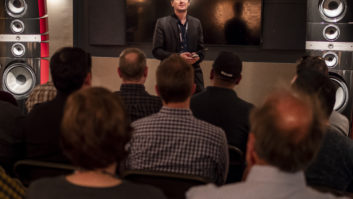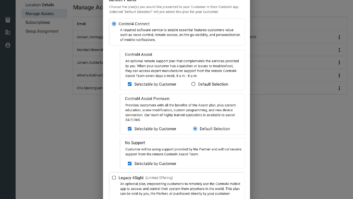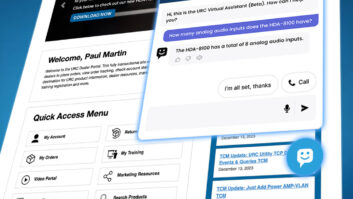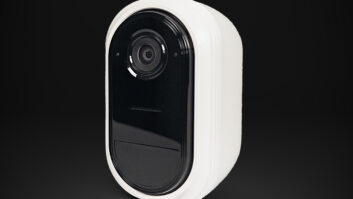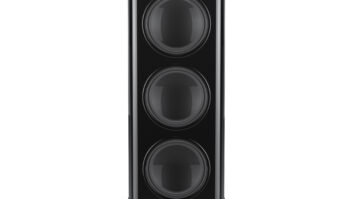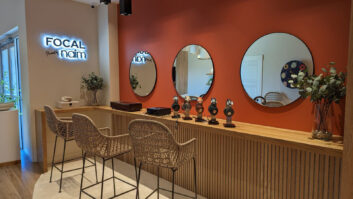Its a crying shame that people in our business and the professional audio community dont talk more. If we did, each side could benefit from things the other has discovered. Case in point: active, or powered, speakers.
Self-powered speakers are not completely foreign to the custom installation industry (weve been using active subwoofers for years) but active main speakers are certainly not the rage like they are in the pro-audio world.
Powered speakers are nothing new. I distinctly remember a line of speakers by Philips in the 70s with active crossover filtering, servo feedback control of the woofer, and built-in amplification. Talk about an innovation! As with subwoofers, powered speakers offer several advantages over traditional power amplifiers and passive speakers. The studio guys are on to something, and the custom install business would do well to stand up and take notice. If its good enough for the pros, its certainly good enough for home theater customers.
Benefits: Powered speakers have active, line-level crossover filters, instead of passive, speaker-level component networks. This makes them much more efficient; no power is lost in the filtering process. The active filters are also less expensive and more flexible, with greater adjustment capability.
A further advantage of active crossover networks is fewer electro-acoustic crossover lobe issues. Any speaker will have some amount of directivity inconsistency in the frequency region of the crossover. At the crossover frequency, the two drivers being integrated are playing at the same level but are at different positions in space (at least on non-concentric designs.) This means that the wave front emanates from two distinct sources instead of one point source. There are unavoidable interference patterns caused by this dual-source system. The wider the region of crossover, the more the interference will be audible. One driver will typically lead the other in time,
either because of physical placement on the baffle or because of inherent phase characteristics in the driver and the crossover circuit. This time discrepancy results in increased sound energy being projected off-axis from the speaker baffle only in the crossover frequency region.
Cancellations of sound energy typically exist in the opposite angle of the baffle axis. Thats all bad because the room isnt energized with an even soundfield, and the speaker will sound different depending on the listening axis. With active crossover circuits, engineers can design around these problems. Having a narrower crossover region and a phase alignment that results in a projection axis continuously perpendicular to the baffle can vastly improve the overall sound of the speaker and its consistency from room to room. In other words, it is easier to place and gets better results more of the time.
Active designs have other advantages as well. Amplifiers can be optimally matched to the drivers needs and its safety margins, and they can include built-in excursion limiters and thermal protection that prevent damage to their drive units. Active speakers can therefore be more reliable and require fewer repairs. The overall system can be more compact because the crossover is more energy-efficient.
There is also the possibility of built-in, configurable directivity and room correction EQ. As examples, Genelecs monitors currently have manual EQ, and B&Os Beolab 5 has an automated EQ process. Finally, there could be widespread use of digital inputs like Meridian speakers have had for years.
Challenges: Active speakers do require that you run two lines to each speaker: AC power and signal. That means AC drops at each speaker location, which is not a huge issue in new construction but time consuming for retrofit projects. One alternative is to put all of the electronics in a head-end unit and run separate speaker wire runs to each of the speaker drive units. Thats the way all but the smallest professional systems (including cinemas) do it, and thats the way the large Genelecs do it too. Overall its the solution I like best, because it keeps all of the electronics in one rack location. Running wires directly to the drivers reduces the effects of speaker wire resistance interacting with the complex load of a traditional crossover circuit. Ultimately, it is always best to keep the speaker wire runs short, so an auxiliary amp rack can be located near the speakers if needed.
To my knowledge only one high-end speaker manufacturer has tried active speakers with external electronics: Waveform. They made speaker systems with outboard, active crossovers, and amplification (both by Bryston) and separate wire runs to each driver set. Interestingly, Waveforms products were well received by both the high-end consumer market and the professional audio community. The Mach 17 resided in Stereophiles Class A, and record label Telarc employed various Waveform models to monitor and mix its recordings. Unfortunately, Waveform is no longer in the business of making speakers.
Another disadvantage of active speakers is the potential for tweeters to receive DC signal under conditions of non-linear operation such as asymmetrical clipping or amplifier malfunction. This would result in almost immediate annihilation of the tweeter, but the problem is easy for the manufacturer to preempt by putting a first-order high-pass filter a few octaves below the intended crossover frequency.
Some people complain that the amplifiers in a powered speaker are of lesser quality than a separate amplifier from a trusted manufacturer. I say, Who knows and who cares? It matters not how good the amp is. What does matter is the combination of amp and speaker as a system, and that is better controlled in powered speakers.
Opportunities: If youre serious about being on the cutting edge of product offerings and technology mix, consider incorporating powered speakers into your arsenal. There are several quality manufacturers to choose from, and more will step up to the plate if they detect a trend toward active designs. You are in control of the trend, so just do it!
Chase Walton contributed to this article. He can be reached at [email protected].
